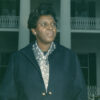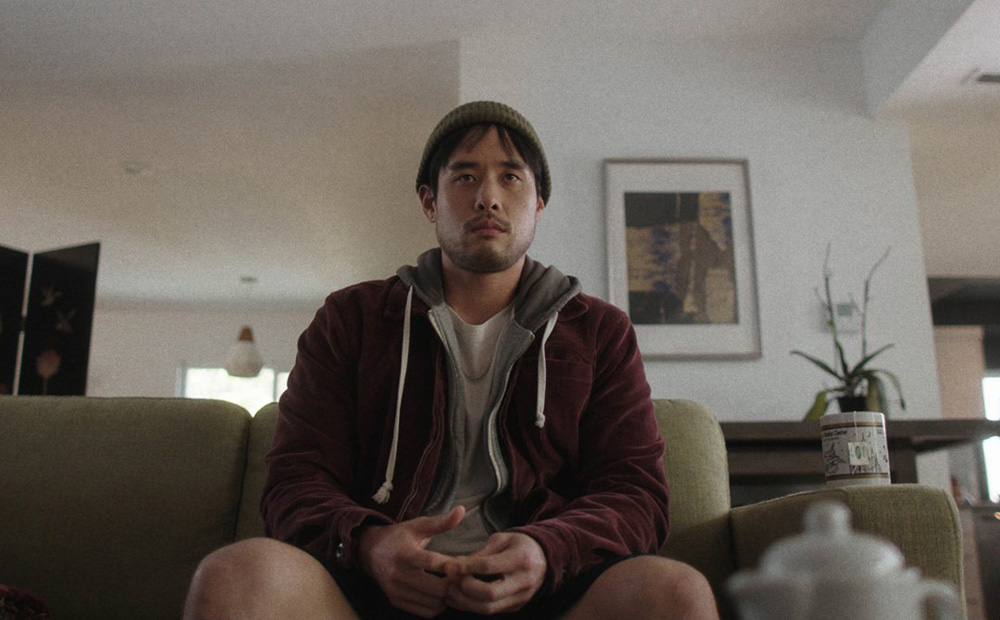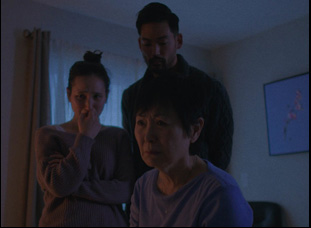Grief can take many forms, and in Julian Doan’s exquisite short “Raspberry,” it arrives in an especially unexpected way. Beautifully capturing the discomfiting feeling of losing a loved one, Doan took inspiration from his own experience to tell the story of a family crowded around their patriarch in his final hours, all unsure how best to express their love for him. One by one, the members of the clan express condolences even when they know words will fail to fully convey their thoughts, but Doan’s camera drifts towards the corner of the darkened room where the youngest son (Raymond Lee) looks particularly at a loss, perhaps not having a change of clothes for days and bereft of the energy to push through such a trying day with a brave face.
With his defenses worn down, the son can only react naturally to the situation unfolding before him and impressively, Doan is able to let an audience’s guard down as well, capturing the abstract feeling so acutely. While the film depicts an end of a life, it seems like only beginning for the filmmaker who gets the gentle seriocomic tone of the inevitably awkward moment just right and shows both discipline and keen perspective in every frame to capture the emotions of the room. In a moment where grief is all around us, “Raspberry” resonates in a particularly powerful way as an exhalation and with its premiere at the Sundance Film Festival this week virtually, the writer/director spoke about how he summoned such a strong sense of place, the small details he pored over and finding a way to honor his own late father.
It’s based on a true story of my dad passing away in 2018. My family and I watched him take his last breath and going through two years of cancer and then two weeks of hospice, you get this elongated amount of time to deal with a tragedy. I recently likened it to watching dailies for a film, seeing all the mundane stuff that’s in between all the drama, and a lot of that I found interesting and very surprising. Dealing with this was not stuff that I felt I had learned about from watching movies or reading things. I was writing a lot about it, and I wanted to try to bring out this just very strange experience of watching something like that happen, and how banal it all feels.
Just because I know that you’re Vietnamese-American, was it much of a decision to make the family Korean?
Really, the decision to make the family Korean was that I knew I wanted to do this with Raymond Lee. He’s a close friend and a very talented actor, and he was the first person to read the script outside of the producer Brianna and my partner. He was immediately taken with it. He saw emotion and the poignancy in it, and I just thought that he could do it perfectly, so really it was casting around Ray and I wanted, of course, not cast a hodgepodge of Asian people to play a family, so we cast them all Korean. There are little nuances and little details that flesh out the absurdity that is specific to being an Asian family, but really when it comes down to it, I think a lot of what’s happening is not specific to any one culture. It’s more universal in that sense, and [making the family Korean] gave me a bit of both worlds. It gave me the elements to put in all of the Asian-American detail. It also removed it enough from myself where I can focus on it being a universal story.
One of the things that I loved throughout this was how you set the audience up for where this goes tonally with small details like the outdated grief pamphlet, but never tip your hand entirely. What was it like building those in?
Yeah, a lot of that’s based on real things. These people bringing in this industrial, clinical gurney that comes in and invades the space in a very loud way. They really did that. I don’t know that it was that loud, but I certainly was standing in the room going like, “What’s happening? This is supposed to be this moment of somber pomp and circumstance, and this thing just doesn’t look elegant.” Then when you’re in hospice, every family is given this pamphlet that is essentially a how to manual on grieving, essentially getting you ready for the end-of-life process, called “Gone From My Sight.” This nurse wrote it. It’s been translated to every imaginable language, and every time people in hospice, they’re given this pamphlet. On the front of it, it has a tall Christopher Columbus-looking ship, and I just thought it was so awkward and funny because we’re an Asian family, and that imagery, a metaphor for the past, of dying and moving on to another life means nothing to us. So I wanted to put those details in there. The challenge was I had to accept at some level that’d people might not catch that, but I did want to try, especially with the gurney moment, to start to pepper in just observations about how absurd the whole enterprise is.
I noticed how accurate it must’ve been when you had a medical consultant on the crew.
Yeah, Alyssa Netto, a friend of mine was in the nursing program when I was in college and was there to advise on some of those things, and some of the things they’d say when they come into the home. She was also there to walk through Harry, the guy who plays the father, in dying realistically, like his breathing patterns and stuff, because I always wanted to start it off with an immediate look on the human being passing away. That was very, very surreal for me, and I really wanted to slam an audience into that experience, so it was important to try and get dying right, which is hard to get on screen. Hopefully, we’ve achieved that.
It struck me as potentially a huge challenge to ramp up to those emotions on set when there’s not much runway in the film to that moment. Was it difficult to get the cast to where they needed to be emotionally?
It was challenging trying to make that identifiable without a lot of dialogue. The [script] was three pages long, and knowing the tone and that the characters, especially Ray’s character, are reactive and don’t have much of a forward drive, I felt like a lot of [figuring] that [out] had to do with showing the family doing something, and then cutting immediately to Ray, and trying to draw connection and distinction between shots. At least in talking with Ray, we talked a lot about the fine balance that we needed to nail of having him essentially effectively not doing anything most of the film, but actually pulling you in and intriguing people, and really making you wonder what’s going on in his head.
I loved his outfit, because he looks a little bit worse for wear than the rest of the family. How did you come up with that costume?
Our costume designer Lydia Graboski-Bauer did a great job. They look very realistic, but [the costumes] say a lot about each character in a very short amount of time and tell a lot of the story that needs to be told about them in absence of a lot of dialogue. With Ray, there was some inspiration from Robert Pattinson’s character from “Good Time.” We looked at him, and it’s a strange combination [of clothes], and we were like, “That guy, he chose to put all these things together. Something that made people feel just like they couldn’t quite place where he was from or why he chose that kind of thing.” [This character] just doesn’t have a put-togetherness, so there was some thought — for me at least — about what he wore that he was rebelling. He’s been rebelling his whole life against this family that he doesn’t connect with, so he tried to go away and find other ways to dress.
You find out so much about him and the rest of the family as well from how you shoot the film and it looks like the location played a big role in figuring that out. How did you find it?
That house is actually the house that my dad died in. That room is where he died, almost in exactly the same position of the bed and everything, so it’s very personal in that way. Of course, I always wrote it with that house in mind. I already pictured that courtyard that opens out to the front door, but when we first started to put everything together, (Turner Munch?) actually called me and he works at the sound stage up in North Hollywood and was like, “We have available stages if you want to shoot that film,” so for about a week-and-a-half, we were planning on shooting this on a sound stage, which sounded cool, but we only had one day to shoot, so I was unsure how we would make this look real and lived in, and make sure it doesn’t look like a set. Because I know the house, I already had the blocking in mind when I wrote it, so [I thought] “Okay. How do I block this? How do they move in a way that’s emotionally engaging for [the actors]?”
We ended up losing that location, which was a bit of a blessing in disguise. We got to shoot it at my dad’s home. My stepmom, his wife, was gracious enough to let 30 strangers into her house at 5 in the morning on a Sunday — it was daylight savings too when time rolled back, so we lost an hour. [laughs] It was at Huntington Beach, so everyone from LA had to drive an hour-and-a-half down to my poor stepmom’s house. We walked in, and we were setting up, and she was still sleeping. It’s emotional material, so I was a little worried about whether or not that was respectful for her. But I was surprised that she was really supportive because she knew my dad would have loved this film and she was just excited. She was taking pictures of the process [and asked] “Can I be in it?” I was like, “Maybe not this time.” [laughs]
What’s it like getting to the finish line with it and getting into Sundance?
For a long time, Sundance felt a little unreal. When I got called by Heidi, the programmer at Sundance,I didn’t really know what to expect and I had my guard up, because I was thinking that they were calling me to give me a “Hey. You didn’t get in, but we just wanted to call and just to express to you how much we really liked the film.” Then she told me, and I just got goosebumps. I tried to keep it cool — I was like, “Yes. That sounds good,” trying to be really mellow about it and I actually told them, “Maybe” at first. I called them later that week to accept the invitation. [laughs] But it’s like a dream come true. It’s a weird year to have gotten in in some ways, but it’s such an honor for them to feature the work with such a small selection of films this year. I’m just so happy that it’s this particular film because I really just set out to make a good film, to do justice to my dad, and to tell a story about the grieving process, and the difficulties of saying goodbye. I’m really excited for people to see it and hopefully, Sundance is just the start.
“Raspberry” will screen at the Sundance Film Festival as part of Shorts Program #2 beginning January 28th at 7 am MT.





